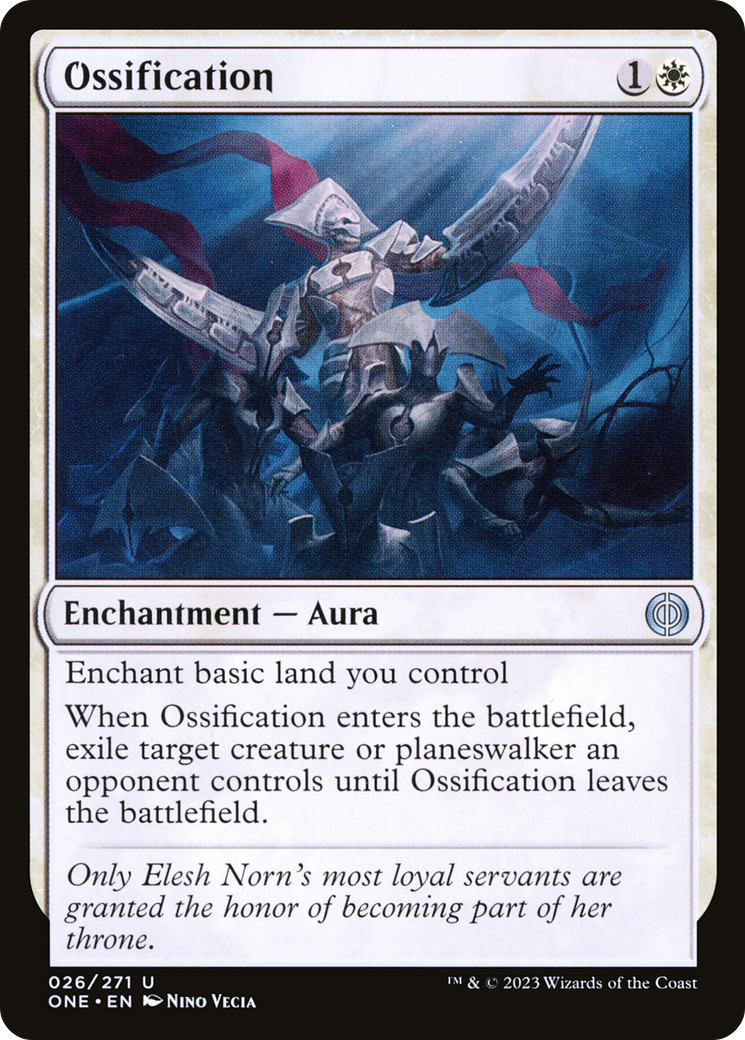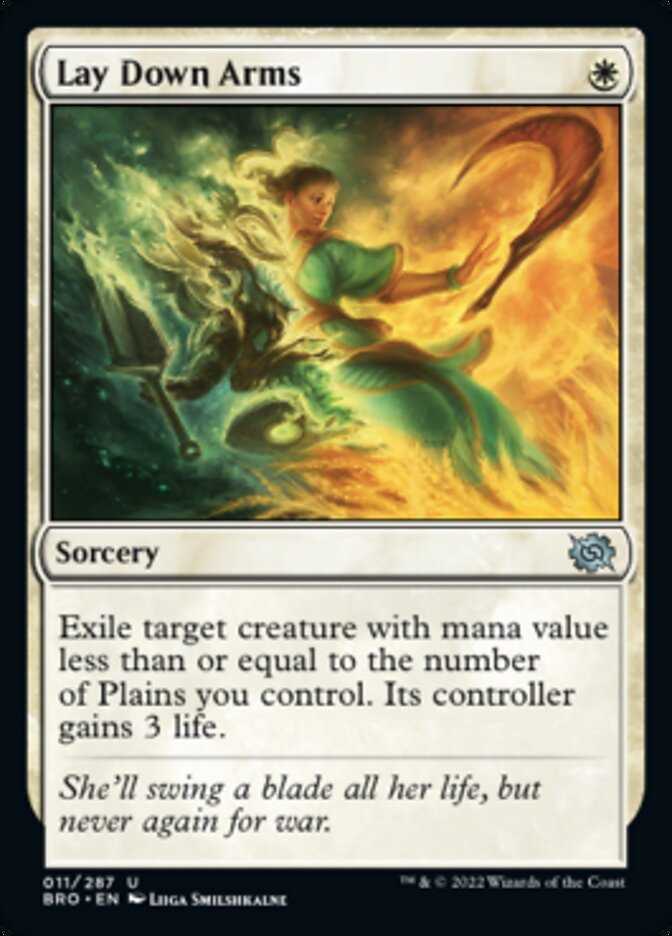Magic: The Gathering is a game that requires careful deck building to achieve victory. However, some cards are more powerful when paired with other cards, leading to a need for optimal deck ratios. In this article, we’ll delve into the deck building strategies required to make the most of Ossification, Lay Down Arms, Knight-Errant of Eos and Invasion of Tarkir.
Using probability theory, we’ll determine the recommended number of lands or creatures needed to support each of these cards in a 60-card deck. Additionally, we’ll study a well-performing deck list from Pro Tour March of the Machine that uses each card to its fullest potential. By the end, you’ll be better equipped to optimize your deck building around these powerful cards and secure your next victory.

In a 26-land, 60-card deck with four Ossification, it’s crucial to have enough basic lands to support casting this powerful card. But what is the probability of drawing a basic land after a certain number of turns?
Assuming you have drawn at least one Ossification and at least two lands after mulligans, the probability of having access to a basic land to support the casting of Ossification depends on the number of basic lands in your deck and how many cards you have drawn. To make things easier, I’ve provided a table with the corresponding conditional probabilities for turns two, three and four, both when you’re on the play and when you’re on the draw. My Python script provides further details on the assumed mulligan strategy and calculations.
| Basics | Probability on turn 2 | Probability on turn 3 | Probability on turn 4 |
| 9 | 76.5% (play) / 80.5% (draw) | 80.6% (play) / 83.9% (draw) | 83.8% (play) / 86.9% (draw) |
| 10 | 80.8% (play) / 84.1% (draw) | 84.3% (play) / 87.4% (draw) | 87.4% (play) / 89.9% (draw) |
| 11 | 84.2% (play) / 87.5% (draw) | 87.5% (play) / 90.2% (draw) | 90.1% (play) / 92.3% (draw) |
| 12 | 87.1% (play) / 90.1% (draw) | 90.0% (play) / 92.5% (draw) | 92.5% (play) / 94.2% (draw) |
| 13 | 89.9% (play) / 92.2% (draw) | 92.3% (play) / 94.2% (draw) | 94.3% (play) / 95.8% (draw) |
| 14 | 92.0% (play) / 94.1% (draw) | 94.0% (play) / 95.8% (draw) | 95.7% (play) / 96.9% (draw) |
| 15 | 93.7% (play) / 95.5% (draw) | 95.5% (play) / 96.8% (draw) | 96.9% (play) / 97.8% (draw) |
| 16 | 95.2% (play) / 96.7% (draw) | 96.7% (play) / 97.7% (draw) | 97.7% (play) / 98.5% (draw |
| 17 | 96.5% (play) / 97.7% (draw) | 97.6% (play) / 98.4% (draw) | 98.4% (play) / 99.0% (draw) |
| 18 | 97.4% (play) / 98.3% (draw) | 98.3% (play) / 98.9% (draw) | 98.9% (play) / 99.3% (draw) |
Suppose that on turn two, you have drawn at least one Ossification and two lands after mulligans in your 26-land, 60-card deck with four Ossification. How likely is it that you’ll have access to a basic land to support the casting of Ossification? Well, if you have 14 basic lands in your deck, the probability according to the table is a solid 92.0 percent on the play. This represents decent consistency, so I recommend to aim for at least 14 basic lands if you’re including Ossification in your deck.
In decks with lower land counts, fewer basic lands will be needed. Due to the nature of probabilistic conditioning and mulligans, the ratio of 14 basics to 26 lands is crucial, not the raw number of 14 basics. For example, Takumi Matsuura’s 22-land Pioneer Mono-White Humans deck with four Ossification and 14 Plains from the Top 8 of Pro Tour Phyrexia had a 94.9 percent probability to hold a basic land on turn two, conditional on drawing at least one Ossification and two lands after mulligans, which is higher than the 92.0 percent number for the 26-land deck. If it weren’t for the fact that Matsuura already had enough utility lands, he might have been fine with 13 basics in his 22-land deck.
In decks that aim to cast Ossification later in the game, fewer basic lands will be needed as well. For example, Sam Bogue’s 20-land Standard Selesnya Enchantments deck with four Ossification and 10 basic lands from the Top 8 of the Second Chance Pro Tour Qualifier at MagicCon Minneapolis would typically cast Jukai Naturalist or Teachings of the Kirin on turn two, while holding Ossification to exile a bigger creature later in the game. This intended sequencing provides more draw steps to find a basic land. In addition, The Restoration of Eiganjo and Commune with Spirits can find a basic land in his deck.
In some mana bases, reaching 14 basic lands is not feasible, but cheap land searchers can pick up the slack. For example, 11 to 12 basic lands and four Herd Migration can also be reasonable in practice. You will not be able to cast Ossification on turn two as reliably with this mana base, but you will be more than fine from turn three onwards. This corresponds to the mana base used by David Olsen in his Standard Five-Color Ramp deck, which he took to the Top 4 of Pro Tour March of the Machine last weekend.

Standard Five-Color Ramp by David Olsen
Artifact (2)
Land (26)
Battle (4)
While I appreciate the power of Mirrex and Boseiju, Who Endures, I believe that one more basic land could be beneficial in Olsen’s deck, and I might have turned one of those nonbasics into a basic. However, overall, this mana base is still acceptable. Olsen’s deck is an exciting option in Standard that can quickly ramp into a turn-five Atraxa, Grand Unifier, going over the top of slower midrange decks. And with Ossification on turn two or three, the deck has an effective early-game defense.
To maximize the potential of Lay Down Arms, you need to ensure that you have enough Plains in your deck. Assuming you have a 60-card deck with four Lay Down Arms and hit all of your land drops, the probability of drawing enough Plains to use this removal spell effectively depends on the number of Plains in your deck relative to the number of non-Plains.





